Vigna mungo
| Vigna mungo | |
|---|---|
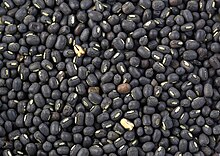
| |
| Dry urad beans | |
| Scientific classification | |
| Kingdom: | Plantae |
| Clade: | Tracheophytes |
| Clade: | Angiosperms |
| Clade: | Eudicots |
| Clade: | Rosids |
| Order: | Fabales |
| Family: | Fabaceae |
| Subfamily: | Faboideae |
| Genus: | Vigna |
| Species: | V. mungo
|
| Binomial name | |
| Vigna mungo | |
| Synonyms[1] | |
| |
Urad beanorblack gram[a](Vigna mungo) is abeangrown inSouth Asia.Like its relative, themung bean,it has been reclassified from thePhaseolusto theVignagenus. The product sold as black gram is usually the whole urad bean, whereas the split bean (the interior being white) is calledwhite lentil.It should not be confused with the much smaller true blacklentil(Lens culinaris).
Black gram originated inSouth Asia,where it has been in cultivation from ancient times and is one of the most highly prizedpulsesofIndia.It is very widely used inIndian cuisine.In India the black gram is one of the important pulses grown in both Kharif and Rabi seasons. This crop is extensively grown in the southern part ofIndiaand the northern part ofBangladeshandNepal.In Bangladesh and Nepal it is known as mash daal. It is a populardaal(legume) side dish in South Asia that goes withcurryand rice as a platter. Black gram has also been introduced to other tropical areas such as theCaribbean,Fiji,Mauritius,MyanmarandAfricamainly by Indian immigrants during theIndian indenture system.
Description
[edit]It is an erect, suberect or trailing, densely hairy, annual bush. The tap root produces a branched root system with smooth, roundednodules.The pods are narrow, cylindrical and up to six cm long. The plant grows 30–100 cm with large hairy leaves and 4–6 cm seed pods.[2]While the urad dal was, along with themung bean,originally placed inPhaseolus,it has since been transferred toVigna.[citation needed]
Cooking
[edit]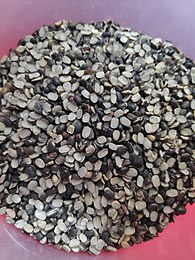
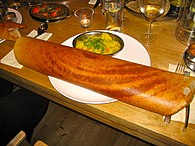
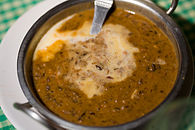
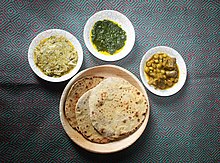

Vigna mungois popular in Northern India, largely used to makedalfrom the whole or split, dehusked seeds. The bean is boiled and eaten whole or, after splitting, made intodal;prepared like this it has an unusualmucilaginoustexture.
Its usage is quite common in Dogra Cuisine ofJammuandLower Himachalregion. The key ingredient ofDal MaddhraorMaah Da Maddhradish served inDogri Dhaamof Jammu isVigna mungolentil.[3]Similarly, another dishTeliya Maahpopular in Jammu & Kangra uses this lentil.[4]Traditionally, Vigna Mungo Lentil is used for preparingDogra styleKhichdiduring Panj Bhikham andMakar Sankrantifestival in Jammu and Lower Himachal. Besides, fermented Vigna Mungo paste is also used to prepareLakhnapuri BhalleorLakhanpuri Laddu( a popular street food of Jammu region).
InUttarakhand Cuisine,Vigna mungois used for preparing traditional dish calledChainsuorChaisu.
InNorth Indian cuisine,it is used as an ingredient ofDal makhani,which is a Modern restaurant style adaptation of TraditionalSabut Urad Dalof Northern India.
In Bengal, it is used inkalai ruti,biulir dal.In Rajasthan, It is one of the ingredients ofPanchmel dalwhich is usually consumed withbati.In Pakistan, it is calledDhuli Mash ki daal[5]and used to makeladdu Pethi walayandBhalla.
It is also extensively used inSouth Indianculinary preparations. Black gram is one of the key ingredients in makingidlianddosabatter, in which one part of black gram is mixed with three or four parts of idli rice to make the batter.Vadaor udid vada also contain black gram and are made from soaked batter and deep-fried in cooking oil. The dough is also used in makingpapadum,in which white lentils are usually used.
In the Telugu states, it is eaten as a sweet in the form of laddoos called Sunnundallu or MinapaSunnundallu.
Nutrition
[edit]| Nutritional value per 100 g (3.5 oz) | |||||||||||||||||||||||||||||||||||||||||||||||||
|---|---|---|---|---|---|---|---|---|---|---|---|---|---|---|---|---|---|---|---|---|---|---|---|---|---|---|---|---|---|---|---|---|---|---|---|---|---|---|---|---|---|---|---|---|---|---|---|---|---|
| Energy | 1,427 kJ (341 kcal) | ||||||||||||||||||||||||||||||||||||||||||||||||
58.99 | |||||||||||||||||||||||||||||||||||||||||||||||||
| Sugars | 0 | ||||||||||||||||||||||||||||||||||||||||||||||||
| Dietary fiber | 18.3 | ||||||||||||||||||||||||||||||||||||||||||||||||
1.64 g | |||||||||||||||||||||||||||||||||||||||||||||||||
25.21 | |||||||||||||||||||||||||||||||||||||||||||||||||
| |||||||||||||||||||||||||||||||||||||||||||||||||
| Other constituents | Quantity | ||||||||||||||||||||||||||||||||||||||||||||||||
| Water | 10.8 | ||||||||||||||||||||||||||||||||||||||||||||||||
| †Percentages estimated usingUS recommendationsfor adults,[6]except for potassium, which is estimated based on expert recommendation fromthe National Academies.[7] | |||||||||||||||||||||||||||||||||||||||||||||||||
Its nutrition numbers when raw differ from when cooked. When raw it contains high levels of protein (25 g/100 g), potassium (983 mg/100 g), calcium (138 mg/100 g), iron (7.57 mg/100 g), niacin (1.447 mg/100 g), thiamine (0.273 mg/100 g), and riboflavin (0.254 mg/100 g).[8]Black gram complements the essential amino acids provided in most cereals and plays an important role in the diets of the people of Nepal and India.[2]Black gram is also very high in folate (628 μg/100 g raw, 216 μg/100 g cooked).[9]
Use in medieval crucible construction
[edit]Inmedieval India,this bean was used in a technique to facilitate making crucibles impermeable.[10]
Names
[edit]This sectionneeds additional citations forverification.(January 2021) |
Vigna mungois known by various names across South and Southeast Asia. Its name in most languages of India derives from Proto-Dravidian*uẓ-untu-,borrowed intoSanskritasuḍida:[11]
- Caribbean Hindustani/Fiji Hindi:उरदी दाल (urdi dal)
- Gujarati:અળદ (aḷad), અડદ (aḍad)
- Hindi:उड़द दाल (uṛad dāl), उरद दाल (urad dāl)
- Kannada:ಉದ್ದು (uddu), ಉದ್ದಿನ ಬೇಳೆ (uddina bēḷe)
- Marathi/Konkani:उडीद (uḍid)
- Malayalam:ഉഴുന്ന് (uẓhunnu)
- Tamil:உளுந்து (uḷuntu/ulundu), உளுத்தம் பாருப்பு (ulutham paruppu)
- Telugu:మినుములు (minumulu) and ఉద్ది పాప్పు (uddi pappu) in Rayalaseema dialect
- Tulu:ಉರ್ದು ಸಲೈ (urdu salāyi)
Its name in selected Indic languages, however, derives from Sanskritmasa(माष):
- Dogri:𑠢𑠬𑠪𑠹 𑠛𑠮 𑠛𑠬𑠥 / माह् दी दाल (maah di daal)
- Assamese:মাটিমাহ (matimah), মাটিকলাই (matikolai)
- Bengali:মাসকালাই ডাল (mashkalai ḍal)
- Nepali:कालो डाल (kalo daal), मास (mās)
- Punjabi:ਮਾਂਹ / ਮਾਸ਼ ਦੀ ਦਾਲ (mānha/māsh di dāl)
- Urdu:ماش کی دال (māsh ki dāl)
Other names include:
- Odia:ବିରି ଡାଲି (biri ḍāli)
- Sinhala:උඳු (undu)
- Myanmar:မတ်ပဲ (matpe)
- Vietnamese:(đậu muồng ăn)
- Thai:ถั่วดำ (thua dam)
Varieties
[edit]Pant Urd 31 (PU-31) Lam Black Gram 884 (LBG 884) Trombay Urd (TU 40)
- Pant U-13
- JU-2
- Type-9
- Barkha
- Gwalior-2
Mutant varieties:CO-1 and Sarla. Spring season varieties:Prabha and AKU-4. First urad bean variety developed in – T9(1948).
See also
[edit]Notes
[edit]- ^Also known as urid bean, minapa pappu, black matpe, matimah, matikolai, mash kalai, maas/kalo daal, uzhunnu/ulundu parippu, or uddu
References
[edit]- ^"The Plant List: A Working List of All Plant Species".Archivedfrom the original on 17 November 2018.Retrieved14 December2014.
- ^ab"Post Harvest Profile of Black Gram"(PDF).Government of India, Ministry of Agriculture. 2006. Archived fromthe original(PDF)on 2014-11-21.Retrieved2014-12-11.
- ^Brien, Charmaine O' (2013-12-15).The Penguin Food Guide to India.Penguin UK.ISBN978-93-5118-575-8.
- ^Gazetteer of the Kangra District: 1883.Calcutta Central Press Company Limited. 1883.
- ^| Dhuli Mash ki Daal
- ^United States Food and Drug Administration(2024)."Daily Value on the Nutrition and Supplement Facts Labels".FDA.Archivedfrom the original on 2024-03-27.Retrieved2024-03-28.
- ^National Academies of Sciences, Engineering, and Medicine; Health and Medicine Division; Food and Nutrition Board; Committee to Review the Dietary Reference Intakes for Sodium and Potassium (2019). Oria, Maria; Harrison, Meghan; Stallings, Virginia A. (eds.).Dietary Reference Intakes for Sodium and Potassium.The National Academies Collection: Reports funded by National Institutes of Health. Washington, DC: National Academies Press (US).ISBN978-0-309-48834-1.PMID30844154.Archivedfrom the original on 2024-05-09.Retrieved2024-06-21.
- ^"Mungo beans, mature seeds, raw".USDA National Nutrient Database for Standard Reference.US Department of Agriculture. Archived fromthe originalon January 7, 2019.
- ^Brink, Martin (2006).Plant resources of tropical Africa 1: cereals and pulses.Wageningen: PROTA Foundation. pp. 206–207.ISBN978-90-5782-170-7.
- ^Vijaya J. Deshpande."Musavijnana or the ancient science of crucibles"(PDF).Indian National Science Academy.Archived(PDF)from the original on 2019-01-07.Retrieved2019-01-07.
- ^Krishnamurti, Bhadriraju (2003).The Dravidian Languages.Cambridge: Cambridge University Press. pp.16.ISBN978-0-521-02512-6.
Bibliography
[edit]- H.K. Bakhru (1997).Foods that Heal. The Natural Way to Good Health.Orient Paperbacks.ISBN978-81-222-0033-1.
- M. Nitin, S. Ifthekar, M. Mumtaz. 2012. Hepatoprotective activity of Methanolic extract of blackgram. RGUHS J Pharm Sci 2(2):62-67.
